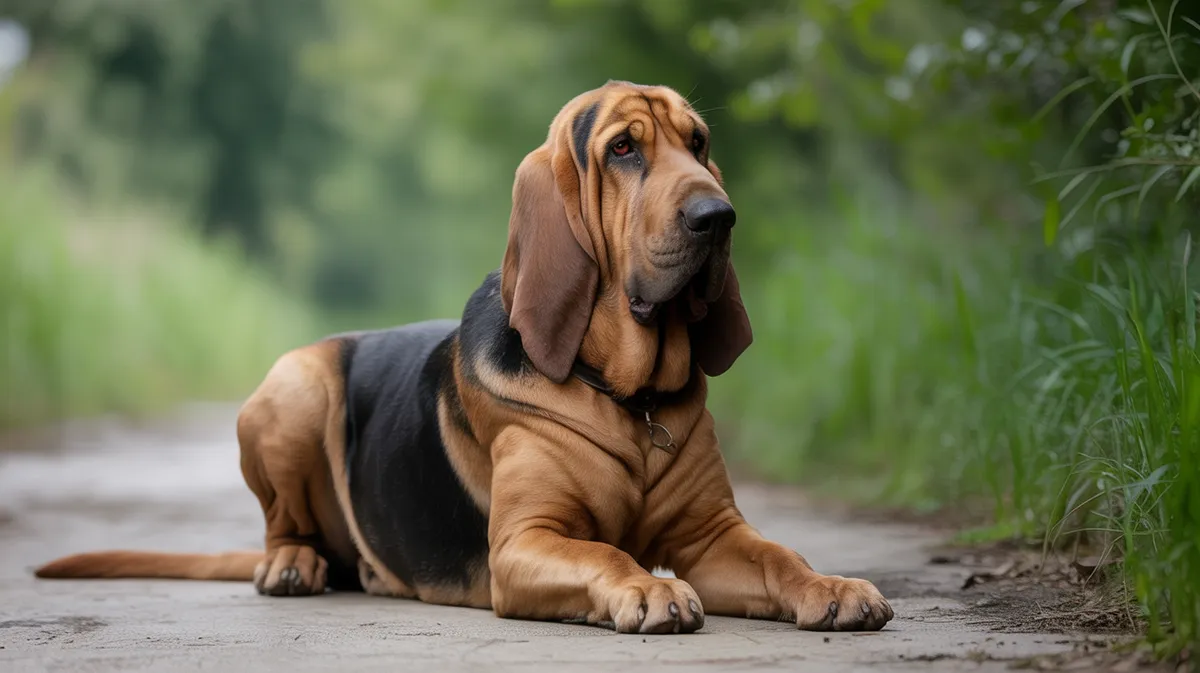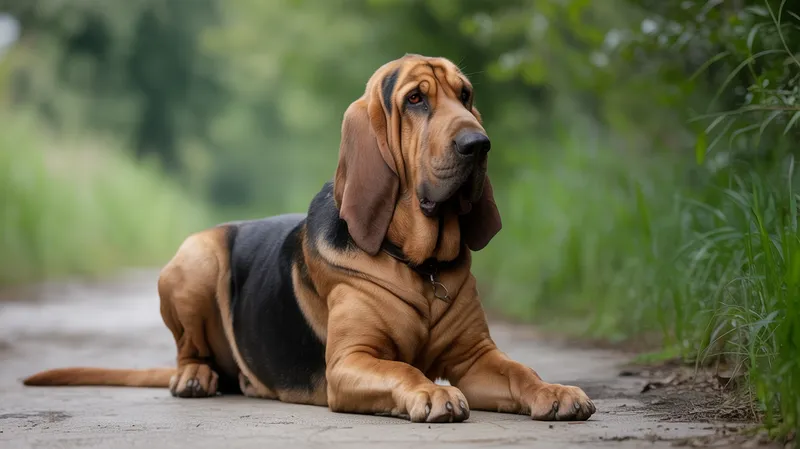
Bloodhound
Canis lupus familiaris

Meet the Bloodhound
The Bloodhound is a large, scent hound originally bred for trailing people and animals over long distances. Known for its remarkable sense of smell, the Bloodhound can track scents that are days old, making it invaluable in search and rescue operations. The breed is easily recognizable by its loose, wrinkled skin, long drooping ears, and dignified, gentle expression. Bloodhounds are friendly and affectionate dogs, though their strong tracking instincts and high energy mean they require regular exercise and mental stimulation.
Classification
Mammal
Habitat
Domestic, often found in rural or suburban environments with access to open areas
Diet
Omnivore
Lifespan
10-12 years
Conservation
Least Concern
Weight
36-50 kg (80-110 lbs)
📖Fascinating Facts
Super Sniffer
Bloodhounds possess up to 300 million scent receptors in their noses, giving them the most powerful sense of smell of any dog breed.
Crime Fighters
Their tracking abilities have made Bloodhounds important partners for police and search teams, and their evidence has been admitted in courts since the 19th century.
Unique Anatomy
The Bloodhound’s long ears and loose skin help funnel scents toward their nose, boosting their tracking performance during searches.
📋Detailed Description
The Bloodhound (Canis lupus familiaris) is a large, powerfully built scent hound renowned for its extraordinary olfactory abilities, considered among the most sensitive in the animal kingdom. Adult males typically stand 64–72 cm (25–28 in) at the shoulder and weigh 46–54 kg (101–119 lb), while females are slightly smaller at 58–66 cm (23–26 in) and 40–48 kg (88–106 lb). The breed is characterized by loose, deeply wrinkled skin, especially around the head and neck, which is thought to help trap scent particles. Its long, pendulous ears and pronounced dewlap further aid in channeling scents toward the nose. Bloodhounds have a deep chest, strong limbs, and a long, tapering tail, all contributing to their endurance and ability to work for hours over rough terrain. Their short, dense coat comes in black and tan, liver and tan, or red. Bloodhounds are gentle, affectionate, and highly intelligent, but can be independent and stubborn due to their strong tracking instincts. They are generally sociable with people and other dogs, though their focus on scent can make them single-minded during work. The breed's remarkable scent-tracking ability has made it invaluable in law enforcement and search and rescue, with documented cases of following trails over 200 km (125 miles) and scents more than 12 days old. Bloodhounds are known for their melodious baying voice, which they use both during tracking and as a form of communication.
💡 Did you know?
A Bloodhound's nose contains approximately 300 million scent receptors—far more than most other dog breeds.
🔬Research & Sources
Wikipedia Summary
The bloodhound is a large scent hound, originally bred for hunting deer, wild boar, rabbits, and since the Middle Ages, for tracking people. Believed to be descended from hounds once kept at the Abbey of Saint-Hubert, Belgium, in French it is called le chien de Saint-Hubert.
Last Modified: 6/10/2025
🎭Behavior & Social Structure
Bloodhounds are highly active and inquisitive, with a strong drive to follow scents. When on a trail, they exhibit intense focus, often ignoring commands or distractions until the scent is lost or the target is found. Their daily routines should include ample physical exercise and mental stimulation, such as scent games or tracking exercises, to prevent boredom and destructive behaviors. Bloodhounds are generally friendly and tolerant, making them suitable family companions, but their size and exuberance require supervision around small children. Socially, they are pack-oriented and thrive in the company of other dogs. In hunting or working contexts, Bloodhounds use a combination of ground scenting and air scenting, moving methodically with their noses close to the ground. They are not natural retrievers or herders and may be less responsive to obedience commands compared to other breeds, reflecting their independent working heritage.
👶Reproduction & Life Cycle
Bloodhounds are sexually mature by 12–18 months, with females typically coming into estrus twice a year. Mating is usually managed by breeders to ensure genetic diversity and health. The gestation period averages 63 days, after which a litter of 6–10 puppies is common, though larger litters have been recorded. Puppies are born blind and deaf, relying on their mother for warmth and nutrition. Maternal care is pronounced, with the dam providing cleaning, feeding, and protection for the first several weeks. Puppies begin to open their eyes and ears at around two weeks and are weaned by six to eight weeks. Early socialization and gentle handling are crucial for developing the breed's even temperament. Bloodhounds are not known for strong paternal involvement, as is typical in domestic dogs.
🛡️Adaptations & Survival
The Bloodhound's most notable adaptation is its olfactory system: it possesses approximately 300 million scent receptors, compared to about 5 million in humans. The breed's large, moist nose, extensive nasal cavity, and specialized olfactory epithelium allow for exceptional scent discrimination. The long ears and loose facial skin help sweep and trap scent particles toward the nostrils as the dog moves. Their muscular build and high stamina enable them to track over long distances and challenging terrain. Behaviorally, Bloodhounds exhibit a strong instinct to follow trails, often to the exclusion of other stimuli, which is a product of centuries of selective breeding for tracking ability. Their deep, resonant bay serves as a communication tool during tracking, alerting handlers to their progress.
📚Research Sources
🎨Cultural Significance
Bloodhounds have a storied place in European history, particularly in Belgium and France, where they were associated with the Abbey of Saint-Hubert and known as the 'St. Hubert Hound.' They have been used since the Middle Ages for tracking game and people, earning a reputation for infallibility in scent work. In modern times, Bloodhounds are iconic in law enforcement, search and rescue, and popular culture, often depicted as the archetypal tracking dog in literature, film, and art. Their image is associated with justice, diligence, and loyalty. The breed's name, 'Bloodhound,' is believed to refer to their 'blooded' or noble lineage rather than any association with blood.
🔬Recent Research & Discoveries
Recent scientific studies have focused on the Bloodhound's olfactory genetics, confirming the presence of an unusually high number of olfactory receptor genes. Research into their use in forensic science has validated the reliability of Bloodhound scent identification in legal contexts, though standards for evidence vary by jurisdiction. Ongoing studies are examining the breed's susceptibility to specific health conditions, with the aim of improving breeding practices and longevity. Advances in canine cognition research have highlighted the Bloodhound's problem-solving abilities and unique working drive. There is also interest in using Bloodhounds for conservation work, such as tracking endangered wildlife or detecting invasive species.
🎥Wildlife Videos

Wildlife - The Fascinating World of Wild Animals | Full Series | Free Documentary Nature
Wildlife - The Fascinating World of Wild Animals | Wildlife Documentary Watch 'Ocean Stories - Full Series' here: ...
Free Documentary - Nature

NORMAN THE BLOODHOUND PART 1
Cameraman - Werner Maritz Editor - Dustin Wetewich All footage and rights belongs to Aquavision TV Productions.
Werner Maritz (Cinamatography)

Wild Colombia - Fantastic Creatures | The Lost Eden | Free Documentary Nature
Wild Colombia - Fantastic Creatures | The Lost Eden | Free Documentary Nature Watch 'Wild Colombia Revealed' here: ...
Free Documentary - Nature

The Baltic | Survival in a Pristine Ecosystem | Animal documentary
Welcome to "The Baltic | Survival in a Pristine Ecosystem", a captivating wildlife documentary that transports you to the serene yet ...
WILD NATURE - Nature animal documentary

A Fox's Tale: Survival in the Alpine Wild | Free Documentary Nature
A Fox's Tale: Survival in the Alpine Wild | Wildlife Documentary Watch 'Megeti - Ethiopia's Lost Wolf' here: ...
Free Documentary - Nature

WILD SIBERIA | Survival Secrets of the Frozen Wilderness | Animal documentary
Welcome to "WILD SIBERIA | Survival Secrets of the Frozen Wilderness" – where we'll explore the extraordinary survival journey ...
WILD NATURE - Nature animal documentary
🌍Habitat Information
The Bloodhound typically inhabits Domestic, often found in rural or suburban environments with access to open areas environments. Bloodhounds have adapted to their environments with specialized features and behaviors.
Primary Habitat:
Domestic, often found in rural or suburban environments with access to open areas
More detailed habitat information will be available soon.
🛡️Conservation Status
The Bloodhound is currently classified as Least Concern. Conservation efforts are crucial for preserving this species for future generations.
Common Threats:
- 🏠Habitat loss and fragmentation
- 🌡️Climate change impacts
- 🎯Hunting and poaching
- 🏭Human-wildlife conflict
⚠️Threats & Conservation Challenges
Bloodhounds are not considered at risk globally, but the breed faces several challenges. Due to their size and deep-chested conformation, they are prone to health issues such as hip and elbow dysplasia, gastric dilatation-volvulus (bloat), and ear infections. The breed's specialized working abilities mean that fewer Bloodhounds are kept as pets compared to other breeds, leading to a decline in numbers in some regions. Responsible breeding is essential to maintain genetic diversity and reduce inherited health problems. Human impact is primarily positive, as Bloodhounds are valued for their working roles, but urbanization and reduced demand for traditional tracking dogs may affect their future population. Lifespan averages 7–10 years, with some individuals living longer with proper care.
🔬Scientific Classification
Scientific Name
Canis lupus familiaris
Classification Hierarchy
🔍 About Taxonomic Classification
Taxonomic classification is a hierarchical system used by scientists to classify and organize living organisms based on shared characteristics and evolutionary relationships.
The system moves from broad categories (Kingdom) to increasingly specific ones, with each animal's scientific name typically consisting of its Genus and species.
📝Community Notes
Share your observations and insights about the Bloodhound with our community of wildlife enthusiasts.
Join Our Community
Sign in to share your observations and connect with fellow wildlife enthusiasts.
Sign In to ContributeNo community notes yet
Be the first to share your observations about the Bloodhound!
Explore Bloodhound
Select a tab above to learn more about this amazing animal.
📸Photo Gallery
No photos available for this animal yet.
🌟Discover More Wildlife
Continue your journey of discovery with more fascinating animals from our database
